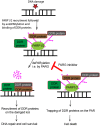Targeting dePARylation for cancer therapy
- PMID: 32010441
- PMCID: PMC6988220
- DOI: 10.1186/s13578-020-0375-y
Targeting dePARylation for cancer therapy
Abstract
Poly(ADP-ribosyl)ation (PARylation) mediated by poly ADP-ribose polymerases (PARPs) plays a key role in DNA damage repair. Suppression of PARylation by PARP inhibitors impairs DNA damage repair and induces apoptosis of tumor cells with repair defects. Thus, PARP inhibitors have been approved by the US FDA for various types of cancer treatment. However, recent studies suggest that dePARylation also plays a key role in DNA damage repair. Instead of antagonizing PARylation, dePARylation acts as a downstream step of PARylation in DNA damage repair. Moreover, several types of dePARylation inhibitors have been developed and examined in the preclinical studies for cancer treatment. In this review, we will discuss the recent progress on the role of dePARylation in DNA damage repair and cancer suppression. We expect that targeting dePARylation could be a promising approach for cancer chemotherapy in the future.
Keywords: ADP-ribosylation; Cancer therapy; DNA damage response; PARG; dePARylation.
© The Author(s) 2020.
Conflict of interest statement
Competing interestsThe authors declare that they have no competing interests.
Figures


Similar articles
-
Targeting dePARylation in cancer therapy.DNA Repair (Amst). 2025 Apr;148:103824. doi: 10.1016/j.dnarep.2025.103824. Epub 2025 Mar 5. DNA Repair (Amst). 2025. PMID: 40056493 Review.
-
DePARylation is critical for S phase progression and cell survival.Elife. 2024 Apr 5;12:RP89303. doi: 10.7554/eLife.89303. Elife. 2024. PMID: 38578205 Free PMC article.
-
DePARylation is critical for S phase progression and cell survival.bioRxiv [Preprint]. 2024 Feb 2:2023.07.31.551317. doi: 10.1101/2023.07.31.551317. bioRxiv. 2024. Update in: Elife. 2024 Apr 05;12:RP89303. doi: 10.7554/eLife.89303. PMID: 37577639 Free PMC article. Updated. Preprint.
-
Targeting dePARylation selectively suppresses DNA repair-defective and PARP inhibitor-resistant malignancies.Sci Adv. 2019 Apr 10;5(4):eaav4340. doi: 10.1126/sciadv.aav4340. eCollection 2019 Apr. Sci Adv. 2019. PMID: 30989114 Free PMC article.
-
The role of dePARylation in DNA damage repair and cancer suppression.DNA Repair (Amst). 2019 Apr;76:20-29. doi: 10.1016/j.dnarep.2019.02.002. Epub 2019 Feb 8. DNA Repair (Amst). 2019. PMID: 30807923 Free PMC article. Review.
Cited by
-
ADP-ribose hydrolases: biological functions and potential therapeutic targets.Expert Rev Mol Med. 2024 Oct 8;26:e21. doi: 10.1017/erm.2024.17. Expert Rev Mol Med. 2024. PMID: 39375922 Free PMC article. Review.
-
Poly (ADP-ribose): A double-edged sword governing cancer cell survival and death.World J Clin Oncol. 2024 Jul 24;15(7):806-810. doi: 10.5306/wjco.v15.i7.806. World J Clin Oncol. 2024. PMID: 39071462 Free PMC article.
-
Prospects for PARG inhibitors in cancer therapy.J Mol Cell Biol. 2025 May 22;16(11):mjae050. doi: 10.1093/jmcb/mjae050. J Mol Cell Biol. 2025. PMID: 39668635 Free PMC article. Review.
-
Poly (ADP-Ribose) Glycohydrolase-Dependent dePARylation of PCNA Is Essential for DNA Replication.FASEB J. 2025 Aug 31;39(16):e70959. doi: 10.1096/fj.202403378R. FASEB J. 2025. PMID: 40827866 Free PMC article.
-
Targeting PARG induces tumor cell growth inhibition and antitumor immune response by reducing phosphorylated STAT3 in ovarian cancer.J Immunother Cancer. 2024 Apr 5;12(4):e007716. doi: 10.1136/jitc-2023-007716. J Immunother Cancer. 2024. PMID: 38580335 Free PMC article.
References
Publication types
Grants and funding
LinkOut - more resources
Full Text Sources

